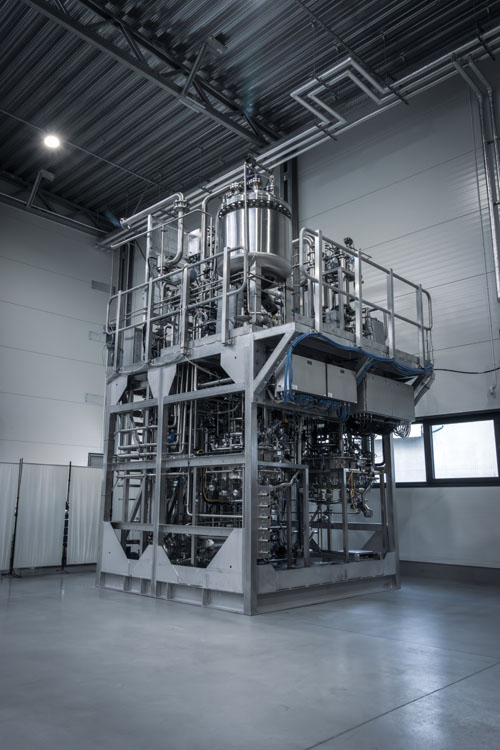In the chemical industry, approximately 80% of production involves multiphase handling and processing (solid-liquid, liquid-liquid, gas-liquid and solid-gas-liquid).
Heat and mass transfers become complicated in the boundary layer of multiphase systems. Yet, if we understand the transport phenomenon in the boundary layer, we can engineer the flow to manage the rate limiting step and intensify the process.
This is the philosophy behind Dec’s solution. Process developers have previously focused on solutions wherein all the existing process steps are converted from batch to continuous flow solutions.
At Dec, we’ve shown that making multi-unit operation processes successful derives from the combination of batch and continuous hybrid systems.
We only advocate continuous unit operation when a significant benefit — such as enhanced product attributes, lower operational costs or reduced solvent waste — can be demonstrated. This results in less complex, more robust, cost-effective and validation-compliant systems.
AWL, a Dec-owned brand, offers a range of fully automated process solutions for both homogenous and multiphase processes under continuous operation. Our expertise lies in providing turnkey solutions for neutralisation, quenching, extraction/leaching, crystallisation, filtration and drying processes.
We excel in effectively managing multiple in-flow phases, ensuring consistent product quality because of tight residence time distribution and process control.
AWL’s continuous processing systems feature a local human-machine interface (HMI) or distributed control system (DCS) for safe operation and can be supplied in a range of sizes from lab to production-scale systems.
Continuous counter current solid-liquid and liquid-liquid extraction
When dealing with temperature-sensitive, low volatility or dilute products, solvent extraction and solute leaching are appealing purification methods.
The AWL advanced counter current high-mixing extraction/leaching column demonstrates huge benefits in terms of reduced processing time, decreased solvent use per unit feed and small footprint.
Advanced reaction and crystallisation technology
AWL’s reactor and crystalliser range includes single and multiple vessel batch or continuous stirred tank reactors (STRs), oscillatory baffled reactors (OBRs), tubular baffled reactors (TBRs) and liquid-liquid contactors (LLCs).
These innovative baffled reactor technologies can handle up to 40% solids with uniform distribution and low power per unit volume whilst operating at pressures up to 50 bar and temperatures up to 200 °C.
The STRs can be run as single-batch reactors, single mixed suspension-mixed product removal (MSMPR) vessels or connected to provide chains or cascades of up to four vessels — all with fully automated and controlled inter-vessel transfers.
Typical two-phase liquid-liquid reactions or neutralisation reactions are mass transfer controlled and demand a high heat transfer area per unit volume. Compared with traditional batch solutions, AWL’s recently engineered liquid-liquid contactor exhibits a significantly higher mass and heat transfer capability.

When it comes to crystallisations, AWL products are ideal for cooling, evaporative and antisolvent processes. The high intensity, low shear mixing leads to minimal particle attrition that, along with excellent heat transfer, allows for the precise control of particle size distribution and morphology.
This flexibility extends to the modes of operation as well (batch, semi- or fully continuous). Temperature-controlled transfer lines prevent unwanted crystallisations or side reactions.
Additionally, probe adapters can be tailored to suit most process analytical technology (PAT) needs, allowing for advanced process control to ensure the product is fine-tuned to deliver the required attributes.
Continuous filtration and drying
Continuous filtration (CF) is a transformative approach to filtering, washing, drying and discharging solids. Its versatility enables the efficient processing of both smaller amounts of active pharmaceutical ingredients (APIs) for product optimisation, as well as larger quantities for production-scale throughput.
Moreover, CF provides a contained, safe and highly controlled way to process hazardous or valuable ingredients, such as highly potent APIs (HPAPIs). The protocols employed in AWL continuous filter dryer systems have numerous advantages.
The absence of mechanical agitation prevents damage or shear to crystals, ensuring their integrity during filtration. The resulting cake filtration is reliable and consistent, whereas the ability to accurately control washing parameters enhances efficiency.
Atomisation nozzles dispense wash solvent without disturbing the cake, promoting effective washing and drying. Furthermore, the thin cake-height technology, ranging from 10–30 mm, improves overall performance.
Options for multiple washes, including solvent exchanges, can be optimised to provide free flowing dry powders from most upstream crystallisation systems.
Low footprint and reduced production times
The key features of these CF systems include a lower footprint compared with traditional batch production facilities, exceptional repeatability and consistency, reduced solvent usage, energy savings and waste reduction.
Most notably, CF achieves significantly lower product loss, with the heel (the residual amount left in the system) reduced to as low as 0.1 mm. The entry to exit cycle time is drastically reduced, making our system highly efficient.
Typical throughputs range from 100 g/h to 25 kg/h of dried product per unit, providing ample capacity for various production needs. Our CF systems guarantee exceptional performance, efficiency and safety in fine chemical, pharmaceutical and laboratory processing operations.
With our state-of-the-art technology, you can unlock new levels of productivity and excellence in your chemical manufacturing process.
Facilities of the future
The future of pharmaceutical production is here and it’s all about flexibility and efficiency. The traditional methods of large-scale batch production are no longer sufficient to meet the changing demands of the industry.
Pharmaceutical companies are now focusing on processes that are more potent and batch sizes that are much smaller, enabling them to produce targeted drugs for a specific population rather than mass-producing drugs for billions of people.
To cater to these changing requirements, the industry is embracing new standards, such as modular type packages (MTPs), which allow for quickly reconfigurable designs to ensure fully flexible production facilities.
This concept has gained popularity among major pharmaceutical companies and even regulatory bodies such as the US FDA are favourable to this approach.
Standards including NAMUR have already been published, providing guidelines for the implementation of modular end-to-end solutions. So, what exactly are MTPs?
Simply put, they are self-contained units that house a specific piece of equipment (a reactor, crystalliser or filter). The equipment remains within the module and can be moved in and out of the production area as required.
The modules have quick connections that are automatically recognised by the control system, making it easy to integrate them into the overall production process.
The module itself contains a file that holds the necessary piping and instrument diagrams, as well as operating details. The benefits of this approach are numerous.
First, MTPs allow for multimodular production systems, meaning that several modules can be configured together to form a complete production line. This allows for easy configuration and reconfiguration, making it possible to quickly change products without the need for recommissioning and validation.
This saves both time and resources. Moreover, this approach is the future of small and medium-scale API production. It eliminates geographical limitations as these modular units can be transported and set up wherever needed.
Additionally, they can easily be connected to common utilities and can dock with other “domino” modules, further increasing their versatility and adaptability. Another important aspect is the environmental impact.
With the option of air extraction or local abatement, these modules offer better control of emissions and waste management. This aligns with the growing focus on sustainable and responsible production practices within the pharmaceutical industry.
In conclusion
The pharmaceutical facility of the future is one that embraces MTPs. This approach is available with AWL continuous technology and allows for increased flexibility, faster product changeovers and improved efficiency.
With the backing of major industry players and regulatory bodies, MTPs are set to revolutionise the way pharmaceuticals are produced, ensuring that the industry can adapt to the changing demands of the market while maintaining high standards of quality and safety.




